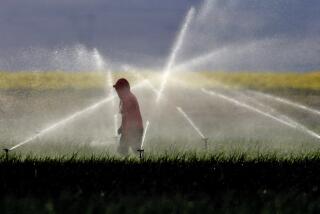Partial Ban on Lethal Pesticide Parathion OKd
WASHINGTON â Moving toward an eventual ban of a pesticide linked to perhaps thousands of deaths around the world, the Environmental Protection Agency said Thursday that it has reached an agreement with producers of parathion to end the most hazardous uses of the chemical in this country by end of the year.
The voluntary accord, reached after weeks of negotiations, will cut by 50% or more the estimated 3 million to 6 million pounds of parathion sprayed on about 90 U.S. crops each year. At the same time, the EPA said that it will initiate action soon to bar the use of parathion on nine crops not covered by the voluntary agreement.
EPA officials had sought a voluntary agreement to end all use of the pesticide in the United States. But Cheminova, a Danish company that manufactures the active ingredient, and the nine American companies that formulate the pesticide balked at withdrawing it from crops that are harvested mechanically.
âWe decided the best course of action was to negotiate what we could and then proceed with regulatory action against the remaining uses,â said Linda Fisher, the EPAâs assistant administrator for pesticides and toxic substances.
Under the voluntary agreement, parathion cannot be used after Dec. 31 on such crops as apples, almonds, oats, peaches and peanuts.
Fisher estimated that it will take 18 months to force an end to the remaining nine uses: alfalfa, barley, canola, corn, cotton, sorghum, soybeans, sunflower and wheat, which account for an estimated 40% to 50% of all parathion use in this country.
Environmental activists, however, predicted that the action could be dragged out for years while parathion continues to threaten the health of farm workers, residents and wildlife in areas where it is used.
Developed in Germany during World War II, parathion is a chemical cousin of deadly agents used by the Nazis during the Holocaust. It has been blamed for more than 300 deaths a year in Japan and many more in India and other parts of the world, including 72 in the United States between 1965 and 1980.
For years, the EPA has required protective clothing for handlers of the product. But poisonings have continued, even in California, where the stateâs safety requirements go beyond those of the federal government.
Because of the stateâs tough controls--including since 1977 some of the precautions only now being introduced by the federal agency--parathion poisonings have declined along with the pesticideâs use.
Between 1982 and 1990, a Cal-EPA official said, use of the chemical declined from 852,000 pounds to 644,000 pounds. Between 1970 and 1975, parathion poisonings averaged 70 per year, but the figure dropped to 22 between 1978 and 1980. Of 350 poisonings of field workers in the state last year, only four were attributed to parathion.
But the Natural Resources Defense Council, which has long pushed for a ban on the chemical, says that parathion poisonings continue even among workers wearing protective clothing and equipment.
In a recent letter to EPA Administrator William K. Reilly, NRDC attorneys Albert Meyerhoff and Lawrie Mott called the pesticide âthe paradigm result of what you have recently and correctly characterized as our âarcane and antiquated national pesticide lawsâ that have failed us so badly.â
In spite of the compoundâs lethal toxicity, Fisher said that the EPA has no evidence that it poses a threat to the food supply, although research continues. Indeed, the agencyâs explanation for not moving earlier against parathion was that it has been more concerned about chemicals posing dietary hazards than about those threatening workers.
While the regulatory process is under way to ban the pesticide from its remaining nine uses, the EPA said that more severe restrictions will be placed upon its handling. Under the agreement, the chemical will be applied only by certified commercial applicators, no hand harvesting will be permitted, re-entry to treated fields will be restricted, buffer zones will be required around areas where it is sprayed and closed systems will be required for transferring the chemical from its containers into airplanes used in spraying operations.
California EPA Secretary James M. Strock promptly endorsed the federal action, calling it âcompletely justifiedâ because of parathionâs toxicity and âthe very small margin for errorâ in its handling.
James W. Wells, interim director of Cal-EPAâs Department of Pesticide Regulation, said that most of the 250,000 pounds of the chemical now in distribution channels, plus an unknown amount already in possession of owners, probably will be used by the end of this year.
State and federal officials pointed out that there are less hazardous and equally satisfactory, if somewhat more expensive, substitutes for parathion, including a chemical cousin, methyl-parathion. Even if substitutes are more expensive, Fisher said, the agreement stopping the chemicalâs use on crops such as almonds, peanuts and pitted fruits should have no impact on food prices since pesticides constitute a small portion of production costs.
Authoritative figures on parathionâs share of the U.S. pesticide market were not immediately available, but EPA officials said the chemical ranks near the top of pesticides now available because it is effective against a broad range of insects that attack 90 crops.
The decline in its use in California is attributed not only to the emergence of new agents, but also to the safety requirements imposed by the state for significantly more than a decade.
As a result of the U.S. action, Fisher predicted that other countries now will take steps to severely restrict or ban the product, which has been the subject of environmentalist warnings dating back to Rachel Carsonâs âSilent Springâ about 30 years ago. In the book, Carson noted that the parathion being applied to California fields and orchards each year was sufficient to âprovide a lethal dose for 5-10 times the whole worldâs population.â
Environmentalists expressed disappointment that EPA did not take action to remove the chemical altogether. Jay Feldman of the National Coalition Against the Misuse of Pesticides suggested that the agency should have invoked its emergency authority to suspend all uses.
âWhile the agency states that it is âpreparing to cancelâ the remaining uses, it sets no deadline for that action,â Feldman said. âThe proposed cancellation may take years, while Cheminova draws the issue into protracted hearings, gleaning the last profits from the sale of its killer chemical all the while.â
Cesar Chavez, president of the United Farm Workers of America, issued a statement calling the action âjust a cheap ploy to give the manufacturers of this deadly pesticide time to get rid of the surplus.â
BACKGROUND
Developed in Germany in World War II, parathion is a chemical cousin of deadly agents used by the Nazis during the Holocaust. But because of its toxicity, its low cost, and the fact that it appeared on the market ahead of pesticides aimed at more specific targets, it became one of the most widely used chemicals in American agriculture, killing pests on 90 different crops. Although it is now outranked by a number of other pesticides in the poisoning of farm workers, it is still considered one of the most dangerous because a small mistake can lead to lethal exposure. Workers are at risk during mixing, loading, application and upon re-entering fields that have been treated. Poisoning is characterized by blurred vision, tightness in the chest, labored breathing, sweating, drooling, frothing at the mouth, muscle spasms, coma, even death.
More to Read
Sign up for Essential California
The most important California stories and recommendations in your inbox every morning.
You may occasionally receive promotional content from the Los Angeles Times.










